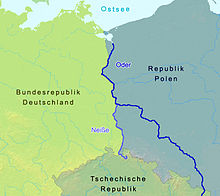The Lusatian Neisse[1][2][3] (German: Lausitzer Neiße; Polish: Nysa Łużycka; Czech: Lužická Nisa; Upper Sorbian: Łužiska Nysa; Lower Sorbian: Łužyska Nysa), or Western Neisse, is a 252-kilometre (157 mi) river in northern Central Europe.[4][5] It rises in the Jizera Mountains, near Nová Ves nad Nisou, at the Czech border becoming the Polish–German border for its remaining 197 kilometres (122 mi), to flow into the similarly northward-flowing Oder from the left.
| Lusatian Neisse | |
|---|---|
 The Neisse near Skerbersdorf, Krauschwitz municipality | |
 Oder and Neisse rivers | |
| Location | |
| Countries | |
| Cities | Liberec, Jablonec nad Nisou, Zittau, Görlitz/Zgorzelec, Gubin/Guben |
| Physical characteristics | |
| Source | Jizera Mountains |
| • location | Nová Ves nad Nisou, Liberec Region, Czech Republic |
| • coordinates | 50°43′47″N 15°13′44″E |
| • elevation | 655 m (2,149 ft) |
| Mouth | Oder |
• location | Neißemünde, Brandenburg, Germany |
• coordinates | 52°4′11″N 14°45′20″E |
• elevation | 32 m (105 ft) |
| Length | 252 km (157 mi) |
| Basin size | 4,403 km2 (1,700 sq mi) |
| Discharge | |
| • average | 31 m3/s (1,100 cu ft/s) |
| Basin features | |
| Progression | Oder→ Baltic Sea |



Its drainage basin covers 4,403 km2 (1,700 sq mi), of which 2,201 km2 (850 sq mi) is in Poland, the rest is mainly in Germany.[6] The river reaches the tripoint of the three nations by Zittau, a German town/city, after 54 kilometres (34 mi), leaving the Czech Republic.[6] It is a left-bank tributary of the Oder, into which it flows between Neißemünde-Ratzdorf and Kosarzyn – north of the towns of Guben and Gubin. The river was a motivations to found Gubin as a craftmanship and trading port in the 13th Century.[7]
Since the 1945 Potsdam Agreement in the aftermath of World War II, the river has partially demarcated the German-Polish border (along the Oder–Neisse line). The German population east of the river was expelled from Poland to Germany.
It is the longest and most watered of the three rivers of its non-adjectival name in both the main languages (the two other rivers being the Eastern Neisse (Polish: Nysa Kłodzka; German: Glatzer Neisse) and Raging Neisse (Polish: Nysa Szalona; German: Wütende Neiße or Jauersche Neiße)). It is usually simply referred to as the Neisse.
Name
Since the river runs through the historic region of Lusatia, the adjective "Lusatian" or "Western" before the name of the river Neisse is used whenever differentiating this border river from the Eastern Neisse (Polish: Nysa Kłodzka, German: Glatzer Neisse) and the smaller Raging Neisse (Polish: Nysa Szalona; German: Wütende Neisse or Jauersche Neisse), both in Poland.
Towns and villages
At Bad Muskau the Neisse flows through Muskau Park, a UNESCO World Heritage Site. Cities and towns on the river from source to mouth include:
- Jablonec nad Nisou, Czech Republic
- Vratislavice, Czech Republic
- Liberec, Czech Republic
- Chrastava, Czech Republic
- Hrádek nad Nisou, Czech Republic
- Zittau, Germany
- Bogatynia, Poland
- Görlitz, Germany; Zgorzelec, Poland
- Pieńsk, Poland
- Bad Muskau, Germany; Łęknica, Poland
- Forst (Lausitz), Germany
- Guben, Germany; Gubin, Poland
Tributaries
Right bank:
Left bank:
See also
References
External links
Wikiwand in your browser!
Seamless Wikipedia browsing. On steroids.
Every time you click a link to Wikipedia, Wiktionary or Wikiquote in your browser's search results, it will show the modern Wikiwand interface.
Wikiwand extension is a five stars, simple, with minimum permission required to keep your browsing private, safe and transparent.
